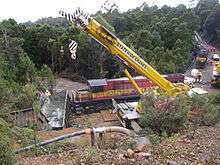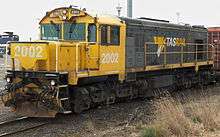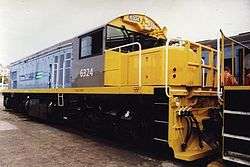New Zealand DQ and QR class locomotives
|
DQ 6324 at Palmerston North | |||||||||||||||||||||||||
| |||||||||||||||||||||||||
| |||||||||||||||||||||||||
| |||||||||||||||||||||||||
| |||||||||||||||||||||||||
The DQ and QR class were a class of diesel locomotives in New Zealand and Tasmania, Australia. Originally built by Clyde Engineering in the 1960s as Queensland Rail 1460 and 1502 class locomotives, they were purchased by Tranz Rail in 1995 to be rebuilt, as a cheaper alternative to buying new locomotives.
Introduction


In 1995, Tranz Rail purchased twenty-one 1460 and four 1502 class locomotives with the intention of rebuilding them for service in New Zealand. Seven 1460 and one 1502 class were shipped to Auckland in early 1998 and hauled to Hutt Workshops in Wellington. Two more batches followed, one on the inter-island rail ferry MV Aratika returning from Brisbane after a heavy engineering inspection.
Tranz Rail split them into two classes. The DQ class were rebuilt with a new cab and low nose and painted in the standard 'Cato Blue' scheme, with dynamic brakes, a computerised control system and rebuilt engine. The QR class were overhauled with auto-transition couplings and repainted in a variant of the 'Cato Blue' livery, these were only used as trailing locomotives as they were not fitted with the safety equipment required to lead trains.
The first locomotive outshopped was ex 1521 in October 1996 as DQ15215, a temporary number that combined the Queensland number with a TMS check digit, it was soon renumbered as DQ 6007 and nicknamed Platypus . Those rebuilt from 1502 class locomotives received 60xx numbers and those from 1460 class received 63xx numbers. This was done to differentiate the different power output of class members. 6007 had a horizontal mounted headlight and numbers below the headlight assembly on the front wall of the cab: the rest had vertical mounted headlights and numbers on either side of the headlight assembly.
The first QR class entered service in October 1997. Three (1499-1501) were not rebuilt but used as sources of spare parts at Hutt Workshops.
Service
DQ 6007 remained in captive service around Wellington for a few months in 1996-97 on shakedown before it was assigned to freight services throughout the lower North Island. Another six DQ and seven QR class followed.
Initially they were not preferred by locomotive crews due to excessive cab noise levels and emissions into the cab.[1] Tranz Rail made modifications to DQ 6324 that reduced the noise level to that acceptable to the Rail & Maritime Transport Union, and also diesel fumes from entering the cab.
During this period, the classes were largely assigned to freight trains. However, DQ 6007 made several appearances on the Capital Connection and Wairarapa Connection long-distance suburban trains in 1996-97 during its shakedown period. On similarly rare occasions a DQ appeared on the Overlander, at least as far as Palmerston North.
It was soon discovered that the DQ class were not particularly reliable. Generator failures were particularly common, and so they were removed from long-distance operations to less-demanding short-haul runs, such as between Middleton Yard in Christchurch and the port of Lyttelton on the final leg of coal trains from the West Coast, and on the Ohai Branch line to and from Invercargill, hauling containerized coal trains. Several were also used as bankers to help trains up the gradients from Dunedin, and later up the 1 in 37 (2.7 %) gradient out of Picton. 1460 class loco No. 1500 was used occasionally as a shunter at Hutt Workshops.
Exports to Tasmania
To alleviate a locomotive shortage at TasRail, which had been purchased by Tranz Rail and its parent company Wisconsin Central in November 1997,[2] a further eight 1460 class were rebuilt at Hutt Workshops and transferred along with Tranz Rail's DQs 6007, 6353 and 6330, and QR 3032. All were repainted in the new red and yellow TasRail livery and renumbered as the DQ2000 class.[3][4]
They were tested on the North Island Main Trunk, receiving temporary TMS numbers that might have become permanent had they remained in New Zealand. The first two were loaded on the MV Polar Queen in mid-1998 with the last arriving in 1999, along with four other ex-Tranz Rail locomotives and two rebuilt ex Westrail D class locomotives.[5]
QR class 2056, 2062 and 2102 were also sent to Tasmania. All were later purchased by TasRail, retaining their Tranz Rail Cato Blue livery. In 2013 the QR class were stored at East Tamar Locomotive Depot in a stripped state.[6]
The DQ class has not been overly reliable in Tasmania either, although de-rating the prime movers resulted in slightly better reliability. Some have been refurbished by TasRail receiving its new charcoal grey and yellow livery.[5] By late 2015, DQs 2003, 2004, 2005, 2007 and 2008 were put into storage, requiring heavy overhauls and other work before being available for use.[7]
Withdrawal in New Zealand
Following the sale of 12 DQs and 3 QRs locomotives to TasRail, Tranz Rail retained DQs 6324, 6347, 6376 and 6382 and QRs 2027, 2079 and 2085. In mid-July 1999 the three QR class were withdrawn and placed in storage at Hutt Workshops,The four DQ class were transferred to the South Island where they were used for banking service between Picton and Wharanui and between Oamaru and Invercargill. They could be seen on the coal shuttles (usually in pairs) between Middleton and Lyttelton. They QRs were used as slave units in both island.
The three QRs were laid up in mid-July 1999 and were sent to Hutt Workshops for storage. DQs 6324 and 6382 were withdrawn in 2002. 6382 was stored at Hillside Workshops and stripped of its six traction motors, while 6324 was stored at Linwood. The other two, 6347 and 6376, were used on the coal dumps between Middleton and Lyttelton. In 2003 the QRs along with the two 1460 locomotives that never were overhauled and used in NZ and three former A locomotives from Western Australia were sold to the National Railway Equipment Company and shipped to Mount Vernon, Illinois. The two 1460s were overhauled are in use with 1500 being used by the Magadi Soda Company in Kenya and renumbered as their No. 5001, while 1501 is now used by CMP in Chile and renumbered as their No.9 and entered service for their new owners in the late 2000s or early 2010s. The other three are where they remain minus a number of components. In the same year the two DQ's in storage were transferred to Hutt Workshops and returned to service with 6324 in the Toll Rail "Corn-Cob" livery. 6347 was withdrawn in December 2009 after it derailed in Picton on the 18th that month, but was later returned to service after being repaired in September 2010. In June 2011 DQ 6376 was damaged when it and leading unit DFT 7117 collided with a slip at Claverly, south of Kaikoura. It was taken to Hutt Workshops and not returned to service, instead becoming a source of spare parts. In February 2013 DQ 6324 had worn its wheelsets down to the point where they needed to be replaced, and was taken out of traffic and laid up at Hutt Workshops. In March 2013 6347 and 6382 were withdrawn from service and laid up at Middleton.
In February 2013 KiwiRail put all four up for sale. In April that year 6347 and 6382 were sold via APEX International, while the other two (along with spares inventory) were sold to the National Railway Equipment Company. In the same month the former pair were towed from Middleton to Auckland and shipped to South Africa a month later after being sold. The pair that were stored at Hutt Workshops were towed to Auckland in July that year and shipped to South Africa on 4 August a month later. They were rebuilt in South Africa by RRL Grindrod for use in Mozambique.[8][9] 6347 and 6382 have been reclassified as RRL22-02 and RRL22-01, while 6324 and 6376 were reclassified as BG15-01 and BG15-02. RRL22-01, RRL22-02 and BG15-01 are operated at the Nacala Corridor for a cement site, while BG15-02 is operated by the Harmony Mining Company in Welkom OFS.

Class register
| Key: | In service | On lease | Out of service | Preserved | Overhaul/Repair | Scrapped |
|---|
| QR no | TMS no | TasRail/RRL Gridrod no | Introduced[n 1] | Location | Current livery | Status/Notes |
|---|---|---|---|---|---|---|
| 1460 | DQ 6382 | RRL22-01 | May 1998 | Mozambique | RRL Grindrod red | Operated by a cement company to work at a site near the Nacala Corridor. |
| 1462 | QR 2027 | October 1997 | Illinois | Tranz Rail Blue | Stored, Mount Vernon, Illinois. | |
| 1465 | DQ 6416 | DQ2006 | February 1999 | Tasmania | Tasrail grey & yellow | Sold to TasRail. |
| 1466 | QR 2033 | DQ2010 | February 1999 | Tasmania | Tasrail grey & yellow | Sold to TasRail. |
| 1467 | DQ 6376 | BG15-02 | May 1998 | Mozambique | RRL Grindrod red | Withdrawn after hitting a slip in Kaikoura, June 2011. Operated by the Harmony Mining Company, Welkom OFS. |
| 1468 | DQ 6330 | DQ2005 | December 1997 | Tasmania | Tasrail Red | Sold to TasRail, withdrawn. |
| 1472 | DQ 6353 | DQ2008 | April 1998 | Tasmania | Tasrail grey & yellow | Sold to TasRail, withdrawn. |
| 1473 | DQ 6324 | BG15-01 | September 1997 | Mozambique | RRL Grindrod red | Operated by a cement company to work at a site near the Nacala Corridor. |
| 1475 | QR 2056 | September 1997 | Tasmania | Tasrail Blue | Sold to TasRail, withdrawn. | |
| 1477 | QR 2062 | October 1997 | Tasmania | Tasrail Blue | Sold to TasRail, withdrawn. | |
| 1481 | DQ 6347 | RRL22-02 | February 1998 | Mozambique | RRL Grindrod red | Operated by a cement company to work at a site near the Nacala Corridor. |
| 1485 | DQ 6399 | DQ2007 | February 1999 | Tasmania | Tasrail Red | Sold to TasRail, withdrawn. |
| 1488 | QR 2079 | November 1997 | Illinois | Tranz Rail Blue | Stored, Mount Vernon, Illinois. | |
| 1489 | QR 2085 | December 1998 | Illinois | Tranz Rail Blue | Stored, Mount Vernon, Illinois. | |
| 1491 | DQ2009 | September 1999 | Tasmania | Tasrail Red | Sold to TasRail. | |
| 1493 | QR 2102 | November 1997 | Tasmania | Sold to TasRail, withdrawn. | ||
| 1495 | DQ2011 | September 1999 | Tasmania | Tasrail Red | Sold to TasRail. | |
| 1497 | DQ2012 | September 1999 | Tasmania | Tasrail grey & yellow | Sold to TasRail. | |
| 1499 | Hutt Workshops | Queensland Rail | Reduced to frame only. Stored and since scrapped at Hutt Workshops | |||
| 1500 | 2000s | Kenya | Magadi Soda Blue | Operated by the Magadi Soda Company, Kenya as their No. 5001. | ||
| 1501 | 2000s | Chile | CMP Blue | Operated by CMP Chile as their No. 9. | ||
| 1502 | QR3032 | DQ2004 | December 1997 | Tasmania | Tasrail Red | Sold to TasRail, withdrawn. |
| 1508 | DQ 6036 | DQ2003 | 1997 | Tasmania | Tasrail Red | Sold to TasRail, withdrawn. |
| 1521 | DQ 6007 | DQ2001 | August 1996 | Tasmania | Tasrail grey & yellow | Formerly DQ 15215, sold to TasRail, rebuilt 2010. It was named Platypus in Tranz Rail service. |
| 1522 | DQ 6013 | DQ2002 | 1997 | Tasmania | Tasrail grey & yellow | Sold to TasRail. |
References
- ↑ "Locomotives of New Zealand". nzrailphotos.co.nz. Retrieved 23 January 2012.
- ↑ Australian Transport Network/Pacific National Tasmanian Government Archives
- ↑ DQ Class Railpage
- ↑ Our Trains DQ (2000) Class TasRail
- 1 2 DQ Class Rail Tasmania
- ↑ QR Class Rail Tasmania
- ↑ http://www.railtasmania.com/loco/loco.php?id=dq
- ↑ "Railpictures.net - Three newly refurbished RRL Grindrod Diesel Locomotives being readied for their journey to Ncala - Mozambique by sea". 16 September 2013.
- ↑ New Zealand locos for South Africa Railways Africa 13 August 2013
- ↑ Introduction dates are by Tranz Rail/TasRail, not Queensland Rail
External links
- http://www.railsoc.org.nz/pub/books.htm Parsons, David - New Zealand Railway Motive Power 2002
